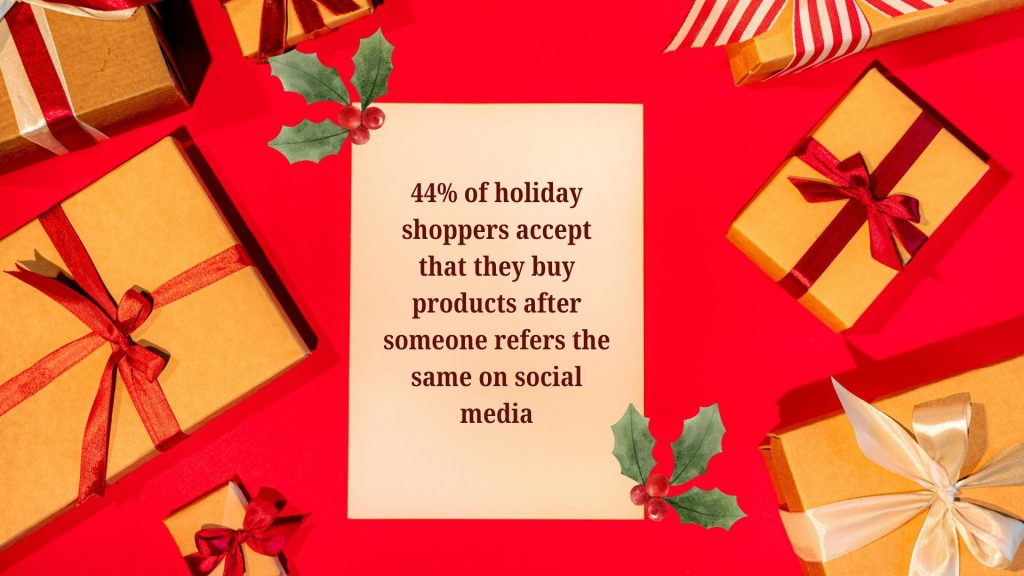Halloween is over, and the fall is falling
Santa is choosing his outfit; the reindeer is grazing
It’s that time of the year
When both children and adults are out shopping!
Okay, the poem was bad (Christ help us), but we assure you – Your brand’s holiday marketing activities won’t be. How? We’ll help you make the most of your marketing efforts through effective lessons to prepare your strategy.

For years, brands have made it their mission to optimize the holiday season to increase their revenue manifold. Last year, holiday sales in the US amounted to $1.309 Trillion, a slight increase from the previous year. Online sales during Black Friday reached about $16.4 billion, while Cyber Monday sales amounted to $12 billion, a 10% rise from that of 2022, according to Google.
But one shouldn’t forget the primary objective of the holiday season – spreading joy and happiness. An aggressive, revenue-based marketing campaign can hurt this very sentiment, resulting in an absolute marketing failure.
Oh, what are you even talking about? How can the promotional efforts of a brand during the holiday season hurt somebody’s sentiments?
If this is what you think, we are glad to present to you some horrible marketing mistakes of the past by renowned brands. You can note the instances, take lessons from them, and create your holiday marketing strategies accordingly.
Marketing Mistakes by Renowned Brands in the Holiday Season
Many times, in the zeal to do something different, brands come up with queer ideas to promote their campaigns. But those ideas don’t brush off well with the audience. Let’s take a few examples of holiday marketing mistakes that some well-known brands made in the past to learn where they went wrong.
The Snapper (John Lewis, 2023)
Although some people may tag this advertisement as “cute”, it didn’t impress a large section of the audience. The tagline of Lewis – Let your traditions grow – also didn’t match the overall theme of the advertisement.
You’ll see that the ad begins with a little boy planting a seed, expecting it to grow into the “Perfect” Christmas tree.

However, the tree grows into a carnivorous plant instead that almost devours the family dog. Hence, the family keeps it outside in the snow, where it supposedly feels lonely. The child that planted it gets outside on Christmas with a present for the cute (but dangerous) plant. He is soon joined by the rest of the family, making it a happy ending.
Queer, that’s true, but the advertisement wasn’t something that depicted happiness and cheer. As a result, it didn’t receive the expected ratings from the audience.
What to learn: What you can learn from this campaign mistake is, not everything creative and unique will be appreciated by the audience. The trick is not to go completely off track. Rely on real-time data to understand audience preferences and the latest trends, while launching an ad, or any other form of marketing campaign.
Magic and Sparkle (Marks & Spencer, 2013)
The TV ad featured some big names, like Rosie Huntington Whitley, Helene Bonham Carter, David Gandy, and others, and appeared quite glitzy and expensive. Further, the crude depiction of an age-old fairy tale ALICE IN WONDERLAND didn’t match the brand’s overall theme and identity.

As we all know, most of the brand’s target audience prefers it for its exquisite quality and inherent affordability. Choosing such well-to-do celebs to enact in its holiday marketing campaign hit the reliability factor. Who would believe that these celebrities will ACTUALLY adorn the brand’s outfit in real life? Several customers felt that Marks & Spencer should have focused more on the marketing content and created something of quality. The glitz and glamour that the brand chose in the ad were unnecessary according to many.
What to learn: While making advertisements, try to make something realistic that your audience can relate to. And because it’s the holidays, your focus should be your audience, their choices, preferences, aspirations, and expectations.
The Boots TV Ad (2013)
The problem was not with the advertisement. It was a promising one, showing a boy, who goes out to deliver gifts to people, who had helped him in life.
It was an amazing message that could have touched the hearts of the audience if not for the background score. The song that they used in the ad was “Small-town Boy” by Bronski Beat. The song highlighted the struggles of the homosexual youth, depicting a boy, who was forced to leave town, because of his orientation.
Mother will never understand why you had to leave
But the answers you seek will never be found at home
The love that you need will never be found at home
Run away, turn away, run away, turn away, run away
Run away, turn away, run away, turn away, run away
Now, this wasn’t the right song to choose for the ad, which was depicting a completely different message. It somehow undermined the pain behind the lyrics, according to some.
What to learn – Every portion of every advertisement that you create is important. Consider researching thoroughly before you choose the background score, the imageries, and even the characters.
Greggs’ Christmas Campaign (2017)
The renowned UK bakery received severe backlash for replacing baby Jesus in the “Gospel of Matthew” imagery with a sausage roll for its pre-Christmas advent calendar. The image was seen in about 1,700 stores throughout the nation and created a severe controversy for insensitivity and hurting the religious sentiments of several Christian groups.

It created such a stir that the chief executive of a Right Wing pressure group, Freedom Association, asked for a nationwide boycott of the brand. Ultimately, the brand’s spokesperson had to apologize to the people for hurting their sentiments.
What to learn: You cannot play with the emotions of even a small section of your audience in the name of creativity. As the holiday marketing strategy is always focused on your customers, their feelings should be your priority.
Poundland’s Naughty Elf (2017)
This one is quite popular, mainly because of the fact that the brand PREFERED to be controversial even after receiving a backlash from some of its audience. However, it still remains to be one of the biggest holiday marketing mistakes of all time.
Okay, so the 2017 holiday marketing campaign for the UK-based variety store featured a queer elf in some rather indecent poses. The elf made its appearance in several of the brand’s social media posts, triggering a large section of its followers. Further, it also violated the policies of the British Advertising Standards Authority, and the media didn’t leave a single chance to bash Poundland’s irresponsibility regarding its “outrageous elf”.

But the funniest part is, even after such a huge backlash, the brand didn’t care and brought back the naughty elf the next year as well. It seemed that the company preferred to be controversial after all!
What to learn – Always try to comply with the advertising standards of your nation and make your ads universally acceptable. It won’t help your brand if your marketing elements are accepted by one section of your audience and rejected by everyone else. There’s a perk in being controversial, true, but it can be dangerous in the long run.
Other Holiday Marketing Mistakes You Should Avoid
People learn from mistakes! That part is true. But do you want the mistakes to be yours or someone else’s? It’s because making mistakes during the active holiday season may lead to:
- Loss of sales
- Loss of revenue
- Losing the chance for another year
- Hurt reputation (if the backlash is severe)
So it better be other’s mistakes, right?
Well, the above examples may have given you some idea. Let’s now help you understand other potential mistakes that marketers tend to make.
Every brand website rushes to get the maximum organic traffic during the season. As a result, they may tend to forget certain things, resulting in holiday marketing failures. The following lessons will prevent such situations.
Don’t forget to prepare your website for the holidays
High loading speed, appealing landing pages, and seamless user experience should be some of the considerations for every brand out there. You should make sure that your website can handle large amounts of traffic during the holiday season. And it should be prepared well in advance, i.e., BEFORE you launch your holiday marketing campaign.

Even if you manage to attract a huge influx of traffic through your promotional activities, they will leave the site if it takes too much time to load. Also, the landing pages should be designed in sync with the holiday theme. Potential customers, who land on your site, shouldn’t face hassles to find the products of their choice. Hence, proper user navigation is mandatory.
Some other things you should do:
- Check your payment processor and update it if necessary
- Launch flash sales with attractive banners to boost customer excitement
- Arrange for a backup server, in case your site goes down due to an enormous traffic influx
- If possible, check for additional integration options to distribute the checkout load
Not enough stocks for holiday purchases
Are you sure that your stocks are thoroughly updated? About 50% of customers, including Brick Friday, Cyber Monday, and Christmas shoppers, were concerned about stock-outs during the holidays last year. No one likes their favorite products going out of stock during the season. If such a thing happens, your customers will immediately flock to your competitor’s site to get what they want.
Replenish your inventories before starting to promote your store for the holidays. Make sure that you can handle bulk orders without delays. You can talk to your team to anticipate the potential demands of your customers while launching the holiday marketing campaigns. Based on real-time data regarding previous experiences of customer behavior, you can update your stocks.
However, note that the stocks running out are normal phenomena during the holidays. The key is to prepare for such scenarios in advance and prevent fuelling customer frustration.
Ignoring mobile purchases
According to the latest statistics, 53% of digital sales will come from mobile devices in the US this year. In 2023, 51.1% of holiday sales were made on Smartphones, a 4% increase from last year.

So, are your holiday marketing activities mobile-optimized? Have you updated your mobile apps along with your website?
If the answer is yes, you’re good to go. But if it’s negative, you’re running short on time to optimize your marketing efforts for mobile devices. Besides, search engines favor promotional activities that are mobile-optimized to give their Smartphone users the best holiday shopping experience.
Here are some holiday marketing hacks to help:
- Create holiday-themed app notifications (push notifications) to grab attention instantly
- Personalize brand messages for occasions, like Black Friday and Cyber Monday, to generate excitement
- Automate customer service during the holiday season to balance the excess burden
- Opt for App Store Optimization ahead of the holidays
- Create appealing social media stories in the form of advent calendars
- Draft content for abandoned cart reminders to notify the abandoners
- If possible, ask some micro-influencers in the industry to promote your app
Coming up with generic promotional content
It can be difficult to come up with unique ideas during the rush of the holiday season. But impersonal messages will leave no impact on the audience. And you will lose the opportunity to increase your revenue during the holiday season.
Hence, take your time and create personalized marketing content for your brand during the holidays. If you don’t have the time to create several marketing copies, it will do. But the ones you craft should be relevant to the preferences, choices, and expectations of your audience, as well as cater to the latest trends in the industry.
What is the key to personalizing your marketing content then?
- Data-driven marketing activities will surely be a successful than generic, idea-based ones. Through real-time data, you can know about your audience preferences better.
- Keep changing and updating your promotional content
Not utilizing multiple channels for holiday marketing
An omnichannel holiday marketing strategy will increase your chances of getting more sales and revenue this season. While optimizing your marketing campaign for search engines and social media is unavoidable, you should also expand into SMS marketing, email marketing, promoting through messaging apps, etc.
You can refer to the simple tips below to develop an omnichannel marketing campaign:
- Personalization is a priority: The first step is to create personalized content for each platform. Spread some holiday cheer in your social media stories, and send greetings through messaging apps and text messages. You should also launch an automated email marketing campaign to promote holiday-themed newsletters regarding your popular products/services.
- Selecting the best channels: Next, you need to sit with your team and shortlist the channels you want to select for your holiday marketing campaign. There are numerous ones, so be very sure of your choice. The key is to prevent clutter and make it visible on the most popular platforms.
- Creating a calendar: Prepare a holiday marketing calendar to streamline the entire process and stay informed of updates, if any. You may need to make significant changes in the marketing content throughout the season. A well-prepared calendar will help reduce the hassles of such tasks.
- Brand consistency is the key: Maintain consistency across all the channels that you promote your products. The theme and feel of your holiday marketing content should be the same, irrespective of the platform. The last thing that you want is to confuse your existing and potential audience.
The cohesive experience will also be helpful for your brand visibility and awareness in the long run, i.e., beyond the holiday season.
Over to You
As you know already, the holiday season is a magical time to make sales and get your brand on the radar of your customers. If you utilize this opportunity to the best of your capabilities, the rest of the year will probably be a cakewalk.
However, there are certain grave mistakes that brands make (mostly in a rush) during the holiday season. While holiday marketing campaigns should be personalized and trendy, brands should also look into some technical stuff to make the entire thing a success. Optimizing for mobile users, preparing the website to handle excess traffic, creating server back-ups, and stocking inventories, are some of the significant areas in a successful holiday marketing campaign.
Also, don’t forget to learn from the mistakes of other brands. The primary focus of any holiday marketing strategy should be the audience. Experimentation is okay, as long as it doesn’t hurt the emotions of your customers.